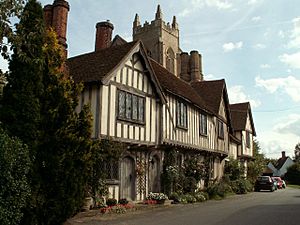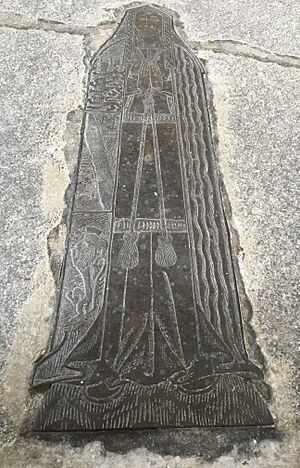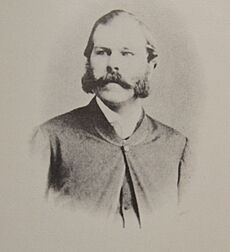Stoke-by-Nayland facts for kids
Quick facts for kids Stoke-by-Nayland |
|
|---|---|
 Stoke-by-Nayland |
|
| Population | 682 (2011) |
| OS grid reference | TL986360 |
| Civil parish |
|
| District |
|
| Shire county | |
| Region | |
| Country | England |
| Sovereign state | United Kingdom |
| Post town | COLCHESTER |
| Postcode district | CO6 |
| Dialling code | 01206 |
| Police | Suffolk |
| Fire | Suffolk |
| Ambulance | East of England |
| EU Parliament | East of England |
| UK Parliament |
|
| Website | Stoke-by-Nayland Parish Council |
Stoke-by-Nayland is a lovely village in Suffolk, England. It's located very close to the border with Essex. The village is part of the Babergh area and includes smaller places like Withermarsh Green, Thorington Street, and Scotland Street.
You'll find many old cottages and houses made with timber frames here. They all surround a big field where people can play and relax. Long ago, this village might have been home to a monastery, which is a place where monks live and work. In 2011, about 682 people lived in Stoke-by-Nayland.
Contents
History
Stoke-by-Nayland has a long history! It was first written about in the year 946. An important earl named Ælfgar mentioned the village in his will. He gave land to a group of people living there, possibly a monastery.
St Mary's Church
The church in Stoke-by-Nayland is called St Mary's Church. It was rebuilt in the 1400s and fixed up again in 1865. This church is so famous that it appears in several paintings by the well-known artist John Constable.
One of the most special parts of the church is its tall tower, made of red bricks. It was finished around 1470 and has stone spires on top. The tower is about 38 meters (126 feet) high! Inside, there's a brass memorial for Lady Catherine Howard. She was the great-grandmother of two of King Henry VIII's wives: Anne Boleyn and Catherine Howard.
Historic Buildings
Stoke-by-Nayland has many old and important buildings. Most of these are houses and cottages that are "listed," meaning they are protected because of their history. Many of them are made of timber frames and have old-fashioned roofs. Some of these houses were built by the family of John Howard, 1st Duke of Norfolk, a very important person in history.
- Giffords Hall is one of the most beautiful old houses in England.
- Thorington Hall is another old house from the 1600s. It has many original details and special windows.
- Downs Farmhouse was built in the early 1500s. It used to be a farmhouse but isn't anymore.
- Street House is on Church Street and has a timber frame with a plain-tile roof.
- The Maltings and the Old Guildhall are two buildings with exposed timber frames. They were designed to look impressive.
Old Writings About the Village
People have written about Stoke-by-Nayland for a long time. Here are some interesting facts from old books:
- In 1868, a book called the National Gazetteer of Great Britain said that Stoke-by-Nayland used to be a market town. It also mentioned the old monastery and the church.
- In 1870, John Marius Wilson wrote in his Imperial Gazetteer of England and Wales that the village had a post office. He also noted that the population had gone down because some silk factories had closed.
- In 1887, John Bartholomew wrote a shorter description in his Gazetteer of the British Isles, mentioning the village's size and population.
Things to Do
Stoke-by-Nayland has some great places for kids and families:
- Schools: The village has two schools: Stoke by Nayland Church of England Primary School and an independent school called OneSchool Global UK.
- Village Hall: The village hall was started in 1911. It's a place where people can meet and lots of different events happen there.
- Golf and Spa: The Stoke By Nayland Hotel Golf and Spa has two 18-hole golf courses. It even hosts big international golf events!
Getting Around
Buses connect Stoke-by-Nayland to other nearby towns and villages. You can catch a bus to places like Hadleigh, Colchester, Ipswich, and Sudbury.
Famous People from Stoke-by-Nayland
Many interesting people have connections to Stoke-by-Nayland:
- John Howard, 1st Duke of Norfolk: A powerful historical figure.
- Lady Catherine Howard nee Molyns: As mentioned, she was the great-grandmother of two of King Henry VIII's wives.
- The Mannock baronets: A noble family who lived at Giffords Hall, Stoke-by-Nayland.
- William Songer: He was born in the village and later traveled to New Zealand. He suggested naming a town there "Stoke" after his birthplace!
- Charles Torlesse:
Born in Stoke-by-Nayland, Charles became an important surveyor in New Zealand. He is buried in the village.
- Rowley Baronets: This family includes Rear-Admiral Sir Joshua Rowley, a famous Royal Navy officer.
- Joshua Francis Rowley: A local politician and public servant who was Lord-Lieutenant of Suffolk.
- Charles Gerald Brocklebank: A brave soldier who fought in World War I and received special awards.
- Lady Anne Windsor: She married Lord Henry Windsor and is buried in St Mary's Church.
- Æthelflæd of Damerham: She was the second wife of King Edmund I of England.
- David Hicks: A well-known interior designer.
- Ralph Agas: A land-surveyor born around 1540 in the village.
- Edward Aggas: A bookseller, printer, and translator.
- Sir William Capell: He was Lord Mayor of London twice in the early 1500s.
- Thomas St Lawrence, 11th Baron Howth: He lived in Stoke-by-Nayland.
- George Webb (cricketer, born 1857): A cricketer.
- Beryl Cook: A famous English artist known for her unique paintings.
Images for kids
















